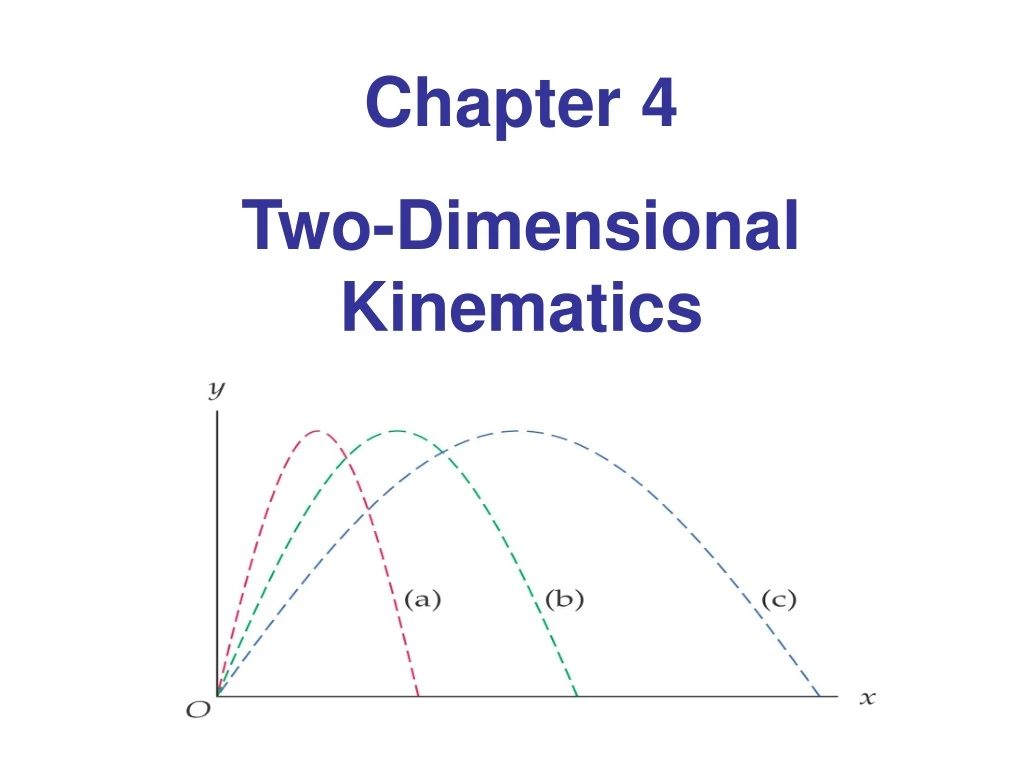A Spring Loaded Gun Can Fire a Projectile

 Download
Download Skip this Video
Loading SlideShow in 5 Seconds..
Chapter 4 Two-Dimensional Kinematics PowerPoint Presentation
Chapter 4 Two-Dimensional Kinematics
Download Presentation
Affiliate four Two-Dimensional Kinematics
- - - - - - - - - - - - - - - - - - - - - - - - - - - East N D - - - - - - - - - - - - - - - - - - - - - - - - - - -
Presentation Transcript
-
Chapter iv Two-Dimensional Kinematics
-
Units of Chapter four • Motion in Two Dimensions • Projectile Motility: Bones Equations • Zippo Launch Bending • General Launch Angle • Projectile Motion: Key Characteristics
-
4-one Move in 2 Dimensions – No Acceleration If velocity is abiding, motion is forth a directly line:
-
iv-1 Motion in Two Dimensions – Constant Acceleration Motion in the x- and y-directions should be solved separately:
-
ConcepTest 4.1a Firing Balls I i) it depends on how fast the cart is moving 2) information technology falls behind the cart three) it falls in front of the cart 4) it falls correct back into the cart 5) information technology remains at rest A small cart is rolling at abiding velocity on a flat track. Information technology fires a ball straight up into the air equally it moves. After information technology is fired, what happens to the ball?
-
ConcepTest 4.1a Firing Balls I when viewed from train when viewed from ground 1) information technology depends on how fast the cart is moving 2) it falls behind the cart three) it falls in front of the cart 4) information technology falls right back into the cart 5) information technology remains at residue A pocket-size cart is rolling at constant velocity on a apartment track. Information technology fires a ball straight upwards into the air as it moves. After it is fired, what happens to the ball? In the frame of reference of the cart, the ball only has a vertical component of velocity. So information technology goes upwardly and comes back down. To a ground observer, both the cart and the ball take the same horizontal velocity, and then the ball still returns into the cart.
-
four-2 Projectile Move: Bones Equations • Assumptions: • ignore air resistance • chiliad = 9.81 m/s2, downward • ignore Earth's rotation • If y-centrality points upward, acceleration in ten-direction is zero and acceleration in y-management is -9.81 one thousand/s2
-
4-ii Projectile Motion: Bones Equations The acceleration is independent of the direction of the velocity:
-
four-2 Projectile Motion: Bones Equations These, then, are the basic equations of projectile motion:
-
4-3 Nothing Launch Angle Launch angle: management of initial velocity with respect to horizontal
-
4-iii Zero Launch Bending In this case, the initial velocity in the y-direction is zero. Here are the equations of motion, with x0 = 0 and y0 = h:
-
ConcepTest four.two Dropping a Package one) rapidly lag backside the plane while falling 2) remain vertically nether the plane while falling 3) move ahead of the aeroplane while falling 4) non fall at all You drop a parcel from a aeroplane flying at abiding speed in a straight line. Without air resistance, the package will:
-
ConcepTest 4.two Dropping a Parcel i) rapidly lag behind the plane while falling 2) remain vertically nether the aeroplane while falling iii) motion ahead of the plane while falling 4) not fall at all You drop a package from a airplane flight at abiding speed in a direct line. Without air resistance, the parcel volition: Both the airplane and the parcel have the samehorizontalvelocity at the moment of release. They will maintain this velocity in the x-management, so they stay aligned. Follow-upwards: What would happen if air resistance is present?
-
ConcepTest 4.3a Dropping the Ball I (one) the "dropped" brawl (2) the "fired" brawl (3) they both hit at the same time (four) it depends on how hard the brawl was fired (5) it depends on the initial tiptop From the sameheight (and at the sametime), ane ball is dropped and another brawl is fired horizontally. Which 1 will hit the ground first?
-
ConcepTest 4.3a Dropping the Brawl I (one) the "dropped" brawl (2) the "fired" ball (3) they both hit at the same time (four) information technology depends on how difficult the ball was fired (five) information technology depends on the initial height From the sameheight (and at the sametime), ane ball is dropped and another ball is fired horizontally. Which 1 will hit the footing first? Both of the balls are falling vertically under the influence of gravity. They both fall from the same peak.Therefore, they will hit the basis at the aforementioned time. The fact that 1 is moving horizontally is irrelevant – remember that the x and y motions are completely independent !! Follow-up: Is that also true if there is air resistance?
-
ConcepTest iv.3b Dropping the Brawl Two ane) the "dropped" ball 2) the "fired" ball 3) neither – they both have the same velocity on bear upon iv) it depends on how hard the ball was thrown In the previous problem, which ball has the greater velocity at basis level?
-
ConcepTest 4.3b Dropping the Brawl II 1) the "dropped" ball two) the "fired" ball 3) neither – they both take the same velocity on touch on four) information technology depends on how hard the ball was thrown In the previous problem, which ball has the greater velocity at ground level? Both balls have the same vertical velocity when they hitting the basis (since they are both acted on by gravity for the same time). However, the "fired" ball also has a horizontal velocity. When yous add the two components vectorially, the "fired" ball has a larger internet velocity when it hits the basis.
-
4-4 Full general Launch Angle In general, v0x = v0 cos θ and v0y = v0 sin θ This gives the equations of move:
-
4-four General Launch Bending Snapshots of a trajectory; cherry dots are at t = 1 s, t = 2 s, and t = three due south
-
four-5 Projectile Motility: Key Characteristics Range: the horizontal distance a projectile travels If the initial and final top are the same:
-
4-five Projectile Motion: Cardinal Characteristics The range is a maximum when θ = 45°:
-
4-5 Projectile Movement: Key Characteristics Symmetry in projectile motility:
-
ConcepTest 4.4a Punts I h one 2 3 4) all take the same hang time Which of the 3 punts has the longest hang time?
-
ConcepTest iv.4a Punts I h 1 2 3 4) all have the same hang fourth dimension Which of the 3 punts has the longest hang time? The time in the air is determined by the vertical motion ! Since all of the punts reach the aforementioned height, they all stay in the air for the same fourth dimension. Follow-up: Which one had the greater initial velocity?
-
ConcepTest four.4bPunts 2 1 2 A battleship simultaneously fires two shells at two enemy submarines. The shells are launched with the aforementioned initial velocity. If the shells follow the trajectories shown, which submarine gets hit first ? 3) both at the same time
-
ConcepTest iv.4bPunts II 1 2 A battleship simultaneously fires 2 shells at ii enemy submarines. The shells are launched with the same initial velocity. If the shells follow the trajectories shown, which submarine gets hit first ? The flying fourth dimension is fixed past the motion in the y-direction. The college an object goes, the longer information technology stays in flight. The beat hit submarine #ii goes less loftier, therefore information technology stays in flight for less time than the other shell. Thus, submarine#2 is hitting starting time. 3) both at the same time Follow-up: Which one traveled the greater distance?
-
ConcepTest 4.6 Spring-Loaded Gun The spring-loaded gun can launch projectiles at different angles with the same launch speed. At what angle should the projectile exist launched in order to travel the greatest distance before landing? ane) 15° ii) 30° three) 45° 4) 60° 5) 75°
-
ConcepTest 4.6 Spring-Loaded Gun The leap-loaded gun can launch projectiles at different angles with the aforementioned launch speed. At what angle should the projectile be launched in guild to travel the greatest distance earlier landing? 1) xv° 2) 30° 3) 45° 4) sixty° five) 75° A steeper angle lets the projectile stay in the air longer, just it does not travel so far because information technology has a small x-component of velocity. On the other hand, a shallow bending gives a large x-velocity, but the projectile is not in the air for very long. The compromise comes at 45°, although this result is all-time seen in a calculation of the "range formula" as shown in the textbook.
-
Example • A golfer hits a shot with an initial speed of 42 one thousand/southward at an angle of 35° above the vertical. Neglect air resistance • What maximum meridian does the brawl accomplish? • How long does it accept to get in that location? • How long does it accept to become back down? • How far does it travel horizontally? • With what velocity (magnitude and direction) will it hit the footing, if information technology lands at the same meridian it started from?
-
Summary of Chapter two • Distance: total length of travel • Deportation: change in position • Average speed: distance / time • Average velocity: displacement / fourth dimension • Instantaneous velocity: average velocity measured over an infinitesimally small time
-
Summary of Chapter 2 • Instantaneous acceleration: average acceleration measured over an infinitesimally pocket-sized fourth dimension • Average acceleration: alter in velocity divided by change in time • Deceleration: velocity and acceleration accept reverse signs • Abiding dispatch: equations of move relate position, velocity, dispatch, and time • Freely falling objects: constant acceleration • g = 9.81 yard/s2
-
Summary of Chapter iii • Scalar: number, with appropriate units • Vector: quantity with magnitude and management • Vector components: Ax = A cos θ, By = B sin θ • Magnitude: A = (Ax2 + Ay2)i/ii • Management: θ= tan-1 (Ay / Ax) • Graphical vector add-on: Place tail of 2nd at head of get-go; sum points from tail of first to head of last
-
Summary of Chapter 3 • Component method: add components of individual vectors, then discover magnitude and direction • Unit vectors are dimensionless and of unit of measurement length • Position vector points from origin to location • Displacement vector points from original position to concluding position • Velocity vector points in management of motion • Acceleration vector points in direction of alter of motility • Relative motion: v13 = v12 + v23
-
Summary of Affiliate 4 • Components of movement in the x- and y-directions can be treated independently • In projectile motion, the acceleration is –g • If the launch angle is nix, the initial velocity has only an x-component • The path followed by a projectile is a parabola • The range is the horizontal distance the projectile travels
Source: https://www.slideserve.com/stevensmichael/chapter-4-two-dimensional-kinematics-powerpoint-ppt-presentation

0 Response to "A Spring Loaded Gun Can Fire a Projectile"
Postar um comentário